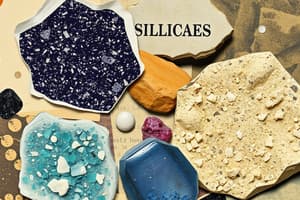Podcast
Questions and Answers
Which of the following statements best describes minerals?
Which of the following statements best describes minerals?
What characteristic distinguishes mineral from mineraloid?
What characteristic distinguishes mineral from mineraloid?
Which category does not include mineral examples?
Which category does not include mineral examples?
What is a notable property of opal that prevents it from being classified as a mineral?
What is a notable property of opal that prevents it from being classified as a mineral?
Signup and view all the answers
What type of mineral is primarily composed of silicon-oxygen tetrahedrons?
What type of mineral is primarily composed of silicon-oxygen tetrahedrons?
Signup and view all the answers
Which of the following is classified as a native metal?
Which of the following is classified as a native metal?
Signup and view all the answers
Which is true regarding sulfates?
Which is true regarding sulfates?
Signup and view all the answers
What differentiates carbonates from other types of minerals?
What differentiates carbonates from other types of minerals?
Signup and view all the answers
What property do minerals lack that disqualifies them from being considered minerals?
What property do minerals lack that disqualifies them from being considered minerals?
Signup and view all the answers
Which of the following is a characteristic of mineraloids?
Which of the following is a characteristic of mineraloids?
Signup and view all the answers
Which mineral classification pertains to compounds formed with halogen ions?
Which mineral classification pertains to compounds formed with halogen ions?
Signup and view all the answers
Which of the following minerals is primarily formed from silicon-oxygen tetrahedrons?
Which of the following minerals is primarily formed from silicon-oxygen tetrahedrons?
Signup and view all the answers
What is the main constituent of pearls?
What is the main constituent of pearls?
Signup and view all the answers
Which mineral category is characterized by metal cations bonded to a sulfate anionic group?
Which mineral category is characterized by metal cations bonded to a sulfate anionic group?
Signup and view all the answers
What distinguishes native metals from other mineral types?
What distinguishes native metals from other mineral types?
Signup and view all the answers
What prevents volcanic glass from being classified as a mineral?
What prevents volcanic glass from being classified as a mineral?
Signup and view all the answers
Which of the following is true regarding the composition of carbonates?
Which of the following is true regarding the composition of carbonates?
Signup and view all the answers
Which type of mineral typically precipitates out of water?
Which type of mineral typically precipitates out of water?
Signup and view all the answers
Study Notes
Minerals
- Minerals are naturally occurring, inorganic solids with definite chemical compositions and ordered internal structures.
- Each mineral is unique, but generally displays specific characteristics.
- Minerals are formed naturally without human intervention.
- Minerals are formed only through inorganic processes; materials from organic processes are not minerals.
- Minerals are solids; liquids and gases are not minerals.
- Minerals have exact chemical formulas containing elements and compounds in specific ratios.
- Some minerals exhibit atomic substitution—an exception to the ratio rule.
- Atoms in minerals have an organized, repetitive geometric pattern called a crystal structure.
- Volcanic glass, although naturally formed, is not a mineral because its internal structure is amorphous.
Mineraloids
- Mineraloids are materials that meet all mineral requirements, except for an organized internal structure.
- Some mineraloids lack more than one mineral requirement.
- Examples: Amber, Opal, Pearl
Amber
- Amber is fossilized tree resin.
- It formed millions of years ago from tree sap.
- Amber can contain trapped organisms inside.
Opal
- Opal is a hydrated, amorphous form of silica.
- Although similar to a mineral, opal's variable molecular structure prevents it from being classified as a mineral.
Pearl
- Pearls are hard, glistening objects formed by shelled mollusks.
- Pearls are mainly composed of CaCO3.
- Pearls may be artificially created by implanting a stimulus in shellfish.
Composition of Minerals
- Minerals are classified according to the elements that compose them.
- These elements are abundant in the Earth's crust.
- Mineral classifications include:
- Silicates
- Oxides
- Sulfides
- Sulfates
- Halides
- Carbonates
- Native metals
Silicates
- Silicates are primarily composed of silicon-oxygen tetrahedrons.
- Examples include olivine and quartz.
Sulfates
- Sulfates consist of metal cations bonded to the sulfate anionic group.
- Sulfates commonly precipitate out of water.
- Examples include gypsum and copper sulfate.
Halides
- Halides consist of halogen ions bonded with other elements.
- Examples include rock salt and fluorite.
Carbonates
- Carbonates possess a carbonic ion.
- Examples include calcite and dolomite.
Native Metals
- Native metals are single or pure metals (elements).
- Examples include copper and gold.
Studying That Suits You
Use AI to generate personalized quizzes and flashcards to suit your learning preferences.
Related Documents
Description
This quiz explores the definitions and characteristics of minerals and mineraloids. Discover the differences between these two categories of substances, including their formation processes and structural properties. Test your knowledge on the essential attributes that classify materials as minerals or mineraloids.




